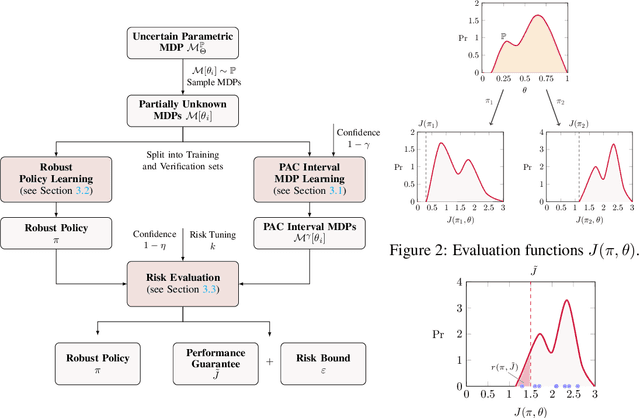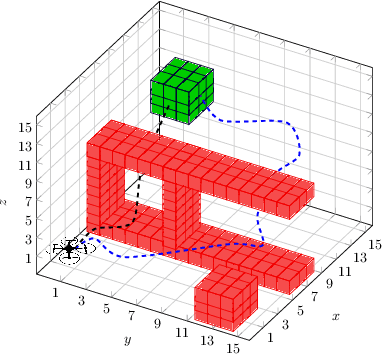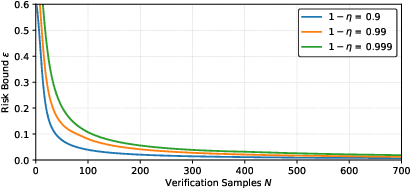David Parker
University of Oxford
Efficient Solution and Learning of Robust Factored MDPs
Aug 01, 2025Abstract:Robust Markov decision processes (r-MDPs) extend MDPs by explicitly modelling epistemic uncertainty about transition dynamics. Learning r-MDPs from interactions with an unknown environment enables the synthesis of robust policies with provable (PAC) guarantees on performance, but this can require a large number of sample interactions. We propose novel methods for solving and learning r-MDPs based on factored state-space representations that leverage the independence between model uncertainty across system components. Although policy synthesis for factored r-MDPs leads to hard, non-convex optimisation problems, we show how to reformulate these into tractable linear programs. Building on these, we also propose methods to learn factored model representations directly. Our experimental results show that exploiting factored structure can yield dimensional gains in sample efficiency, producing more effective robust policies with tighter performance guarantees than state-of-the-art methods.
Learning Probabilistic Temporal Logic Specifications for Stochastic Systems
May 17, 2025Abstract:There has been substantial progress in the inference of formal behavioural specifications from sample trajectories, for example, using Linear Temporal Logic (LTL). However, these techniques cannot handle specifications that correctly characterise systems with stochastic behaviour, which occur commonly in reinforcement learning and formal verification. We consider the passive learning problem of inferring a Boolean combination of probabilistic LTL (PLTL) formulas from a set of Markov chains, classified as either positive or negative. We propose a novel learning algorithm that infers concise PLTL specifications, leveraging grammar-based enumeration, search heuristics, probabilistic model checking and Boolean set-cover procedures. We demonstrate the effectiveness of our algorithm in two use cases: learning from policies induced by RL algorithms and learning from variants of a probabilistic model. In both cases, our method automatically and efficiently extracts PLTL specifications that succinctly characterise the temporal differences between the policies or model variants.
Planning with Linear Temporal Logic Specifications: Handling Quantifiable and Unquantifiable Uncertainty
Feb 26, 2025Abstract:This work studies the planning problem for robotic systems under both quantifiable and unquantifiable uncertainty. The objective is to enable the robotic systems to optimally fulfill high-level tasks specified by Linear Temporal Logic (LTL) formulas. To capture both types of uncertainty in a unified modelling framework, we utilise Markov Decision Processes with Set-valued Transitions (MDPSTs). We introduce a novel solution technique for the optimal robust strategy synthesis of MDPSTs with LTL specifications. To improve efficiency, our work leverages limit-deterministic B\"uchi automata (LDBAs) as the automaton representation for LTL to take advantage of their efficient constructions. To tackle the inherent nondeterminism in MDPSTs, which presents a significant challenge for reducing the LTL planning problem to a reachability problem, we introduce the concept of a Winning Region (WR) for MDPSTs. Additionally, we propose an algorithm for computing the WR over the product of the MDPST and the LDBA. Finally, a robust value iteration algorithm is invoked to solve the reachability problem. We validate the effectiveness of our approach through a case study involving a mobile robot operating in the hexagonal world, demonstrating promising efficiency gains.
Robust Markov Decision Processes: A Place Where AI and Formal Methods Meet
Nov 18, 2024Abstract:Markov decision processes (MDPs) are a standard model for sequential decision-making problems and are widely used across many scientific areas, including formal methods and artificial intelligence (AI). MDPs do, however, come with the restrictive assumption that the transition probabilities need to be precisely known. Robust MDPs (RMDPs) overcome this assumption by instead defining the transition probabilities to belong to some uncertainty set. We present a gentle survey on RMDPs, providing a tutorial covering their fundamentals. In particular, we discuss RMDP semantics and how to solve them by extending standard MDP methods such as value iteration and policy iteration. We also discuss how RMDPs relate to other models and how they are used in several contexts, including reinforcement learning and abstraction techniques. We conclude with some challenges for future work on RMDPs.
Expectation vs. Reality: Towards Verification of Psychological Games
Nov 08, 2024Abstract:Game theory provides an effective way to model strategic interactions among rational agents. In the context of formal verification, these ideas can be used to produce guarantees on the correctness of multi-agent systems, with a diverse range of applications from computer security to autonomous driving. Psychological games (PGs) were developed as a way to model and analyse agents with belief-dependent motivations, opening up the possibility to model how human emotions can influence behaviour. In PGs, players' utilities depend not only on what actually happens (which strategies players choose to adopt), but also on what the players had expected to happen (their belief as to the strategies that would be played). Despite receiving much attention in fields such as economics and psychology, very little consideration has been given to their applicability to problems in computer science, nor to practical algorithms and tool support. In this paper, we start to bridge that gap, proposing methods to solve PGs and implementing them within PRISM-games, a formal verification tool for stochastic games. We discuss how to model these games, highlight specific challenges for their analysis and illustrate the usefulness of our approach on several case studies, including human behaviour in traffic scenarios.
Learning Provably Robust Policies in Uncertain Parametric Environments
Aug 06, 2024



Abstract:We present a data-driven approach for learning MDP policies that are robust across stochastic environments whose transition probabilities are defined by parameters with an unknown distribution. We produce probably approximately correct (PAC) guarantees for the performance of these learned policies in a new, unseen environment over the unknown distribution. Our approach is based on finite samples of the MDP environments, for each of which we build an approximation of the model as an interval MDP, by exploring a set of generated trajectories. We use the built approximations to synthesise a single policy that performs well (meets given requirements) across the sampled environments, and furthermore bound its risk (of not meeting the given requirements) when deployed in an unseen environment. Our procedure offers a trade-off between the guaranteed performance of the learned policy and the risk of not meeting the guarantee in an unseen environment. Our approach exploits knowledge of the environment's state space and graph structure, and we show how additional knowledge of its parametric structure can be leveraged to optimize learning and to obtain tighter guarantees from less samples. We evaluate our approach on a diverse range of established benchmarks, demonstrating that we can generate highly performing and robust policies, along with guarantees that tightly quantify their performance and the associated risk.
Safe POMDP Online Planning among Dynamic Agents via Adaptive Conformal Prediction
Apr 23, 2024Abstract:Online planning for partially observable Markov decision processes (POMDPs) provides efficient techniques for robot decision-making under uncertainty. However, existing methods fall short of preventing safety violations in dynamic environments. This work presents a novel safe POMDP online planning approach that offers probabilistic safety guarantees amidst environments populated by multiple dynamic agents. Our approach utilizes data-driven trajectory prediction models of dynamic agents and applies Adaptive Conformal Prediction (ACP) for assessing the uncertainties in these predictions. Leveraging the obtained ACP-based trajectory predictions, our approach constructs safety shields on-the-fly to prevent unsafe actions within POMDP online planning. Through experimental evaluation in various dynamic environments using real-world pedestrian trajectory data, the proposed approach has been shown to effectively maintain probabilistic safety guarantees while accommodating up to hundreds of dynamic agents.
HSVI-based Online Minimax Strategies for Partially Observable Stochastic Games with Neural Perception Mechanisms
Apr 16, 2024

Abstract:We consider a variant of continuous-state partially-observable stochastic games with neural perception mechanisms and an asymmetric information structure. One agent has partial information, with the observation function implemented as a neural network, while the other agent is assumed to have full knowledge of the state. We present, for the first time, an efficient online method to compute an $\varepsilon$-minimax strategy profile, which requires only one linear program to be solved for each agent at every stage, instead of a complex estimation of opponent counterfactual values. For the partially-informed agent, we propose a continual resolving approach which uses lower bounds, pre-computed offline with heuristic search value iteration (HSVI), instead of opponent counterfactual values. This inherits the soundness of continual resolving at the cost of pre-computing the bound. For the fully-informed agent, we propose an inferred-belief strategy, where the agent maintains an inferred belief about the belief of the partially-informed agent based on (offline) upper bounds from HSVI, guaranteeing $\varepsilon$-distance to the value of the game at the initial belief known to both agents.
Learning Algorithms for Verification of Markov Decision Processes
Mar 20, 2024



Abstract:We present a general framework for applying learning algorithms and heuristical guidance to the verification of Markov decision processes (MDPs). The primary goal of our techniques is to improve performance by avoiding an exhaustive exploration of the state space, instead focussing on particularly relevant areas of the system, guided by heuristics. Our work builds on the previous results of Br{\'{a}}zdil et al., significantly extending it as well as refining several details and fixing errors. The presented framework focuses on probabilistic reachability, which is a core problem in verification, and is instantiated in two distinct scenarios. The first assumes that full knowledge of the MDP is available, in particular precise transition probabilities. It performs a heuristic-driven partial exploration of the model, yielding precise lower and upper bounds on the required probability. The second tackles the case where we may only sample the MDP without knowing the exact transition dynamics. Here, we obtain probabilistic guarantees, again in terms of both the lower and upper bounds, which provides efficient stopping criteria for the approximation. In particular, the latter is an extension of statistical model-checking (SMC) for unbounded properties in MDPs. In contrast to other related approaches, we do not restrict our attention to time-bounded (finite-horizon) or discounted properties, nor assume any particular structural properties of the MDP.
Partially Observable Stochastic Games with Neural Perception Mechanisms
Oct 17, 2023Abstract:Stochastic games are a well established model for multi-agent sequential decision making under uncertainty. In reality, though, agents have only partial observability of their environment, which makes the problem computationally challenging, even in the single-agent setting of partially observable Markov decision processes. Furthermore, in practice, agents increasingly perceive their environment using data-driven approaches such as neural networks trained on continuous data. To tackle this problem, we propose the model of neuro-symbolic partially-observable stochastic games (NS-POSGs), a variant of continuous-space concurrent stochastic games that explicitly incorporates perception mechanisms. We focus on a one-sided setting, comprising a partially-informed agent with discrete, data-driven observations and a fully-informed agent with continuous observations. We present a new point-based method, called one-sided NS-HSVI, for approximating values of one-sided NS-POSGs and implement it based on the popular particle-based beliefs, showing that it has closed forms for computing values of interest. We provide experimental results to demonstrate the practical applicability of our method for neural networks whose preimage is in polyhedral form.
 Add to Chrome
Add to Chrome Add to Firefox
Add to Firefox Add to Edge
Add to Edge